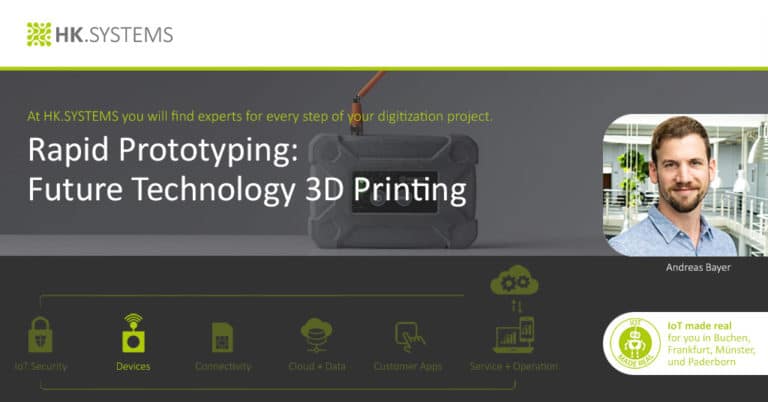High-quality plastic parts using the flexible 3D printing process as a fast, cost-effective alternative to the far more complex injection molding process: That’s what rapid prototyping is all about! HK.SYSTEMS uses this innovative additive manufacturing technology in conjunction with CNC-controlled machines not only for prototypes, but also for the realization of medium and small series.
Why? Now – with rapid prototyping, we not only sustainably save weight and costs for our customers during the production of various devices and components: we can also react quickly to changing requirements during the ongoing production process, order according to the situation and thus avoid costly warehousing. Rapid prototyping enables us to produce high-precision prototypes directly from existing CAD data – faster than ever before. And these prototypes not only look like the end products – they also work like them. Design and function can be optimized quickly and easily in this way.
These options are not available for injection molded parts because the entire injection mold has to be modified or even rebuilt at great expense. In the additive manufacturing process, on the other hand, the data record is simply changed and the changes are entered in the next batch – that’s it. Even better: the parts price remains the same.
However, we don’t just develop individual parts for our customers’ IoT projects using rapid prototyping: We also manufacture entire complex assemblies with special mechanical properties that can often only be realized through the use of additive manufacturing methods. We also create the basis for the necessary PoCs (proof of concepts) and for functional models to test the technical functions of all relevant parts and components.

Rapid Prototyping, Rapid Tooling, Rapid Manufacturing
Rapid prototyping often refers to the functional interaction between rapid tooling and rapid manufacturing: rapid tooling is the rapid production of tools using the 3D printing process, while rapid manufacturing refers to the production of functioning end products. Rapid prototyping technology does not require costly and time-consuming tool production: The same device can be used to create virtually any number of different geometries. Errors and inaccuracies can be quickly and easily identified in the resulting physical models. Another advantage: quickly created, real models increase employee motivation and commitment. They can view and check the models far more precisely and in greater detail than on screen - the feedback for optimized implementation is correspondingly clearer. The so-called trial-and-error process is therefore considerably more time-saving, cost-effective and uncomplicated with the help of rapid prototyping. And last but not least, there is considerably less waste that would be produced by other manufacturing processes such as milling, turning or grinding. This protects the environment, saves resources and eases the strain on budgets. To conclude, here are the biggest and most convincing advantages of rapid prototyping technology at a glance: - Short production time: only a few days to prototype - Sustainability: less material waste - Customization: quick adaptation of 3D data - On Demand Order: short-term + flexible production - Implementation of lightweight structures: diverse possibilities - Low manufacturing costs: no high tooling costs - Freely scalable: complex geometries possible - Efficient test methodology: cost-effective, fast test printing
Andreas Bayer from our partner company Hoffmann + Krippner is our expert for additive manufacturing. If you have any questions, he will be happy to answer them:
